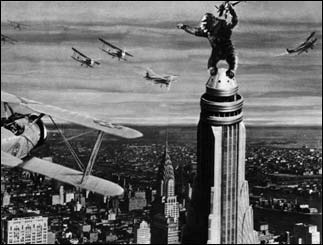Among the most interesting posts I've ever read.
Michael C. LaBarbera, professor in Organismal Biology & Anatomy & Geophysical Sciences at the College of the University of Chicago, has written an unbelievably interesting piece about the science behind horror movies like King Kong, The Incredible Shrinking Women, Them, and Fantastic Voyage. An incredibly interesting read.
In The Incredible Shrinking Man (1957), the hero is exposed to radioactive toxic waste and finds himself growing smaller and smaller. He is lost to family and friends while fending off the household cat and must make his own way in a world grown monstrously large. He forages food from crumbs and drinks from puddles of condensation. In one famous scene, he defends himself against a house spider by using an abandoned sewing needle, which he has to struggle to lift.
Stop the projector! Time for a little analysis...
 And on King Kong...
And on King Kong...
... Back to King Kong. Based on some measurements from stills from the original movie, at the beginning of the movie Kong is about 22 feet tall, but by the time he climbs the Empire State Building, he appears to be 50 percent bigger, presumably because he was allowed bananas ad libitum. At 22 feet tall, Kong is about four to five times the size of your garden-variety lowland gorilla. A fivefold increase in height implies a 25-fold increase in bone cross-sectional area and a 125-fold increase in body mass; the stress on the bones thus should be about five times greater than the stress on a normal gorilla's bones. But, remember, according to Andy Biewener's data, a safety factor of five is extreme for mammals; Kong's excessive body size should have exhausted the safety factor. True, Kong stands a bit straighter than the average gorilla so he may gain a bit of the safety factor back, but it's clear that he's pushing the envelope. Is that why he has such a short fuse and is always roaring and bashing things? Not only does he continually run the risk of breaking his legs, but undoubtedly his feet hurt.
 Tue, November 7, 2006 at 8:32 PM in
Tue, November 7, 2006 at 8:32 PM in  My Favorite Posts
My Favorite Posts  The Biology of B-Movie Monsters
The Biology of B-Movie Monsters 


Reader Comments (1)